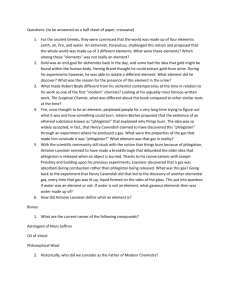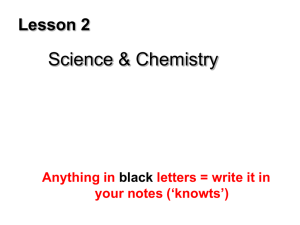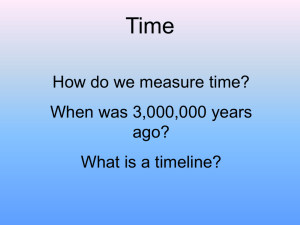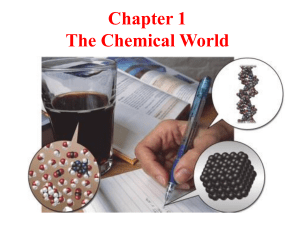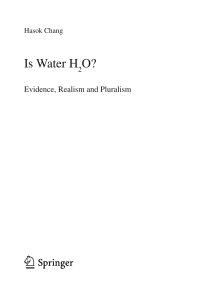ELEMENTS AND ATOMS
advertisement
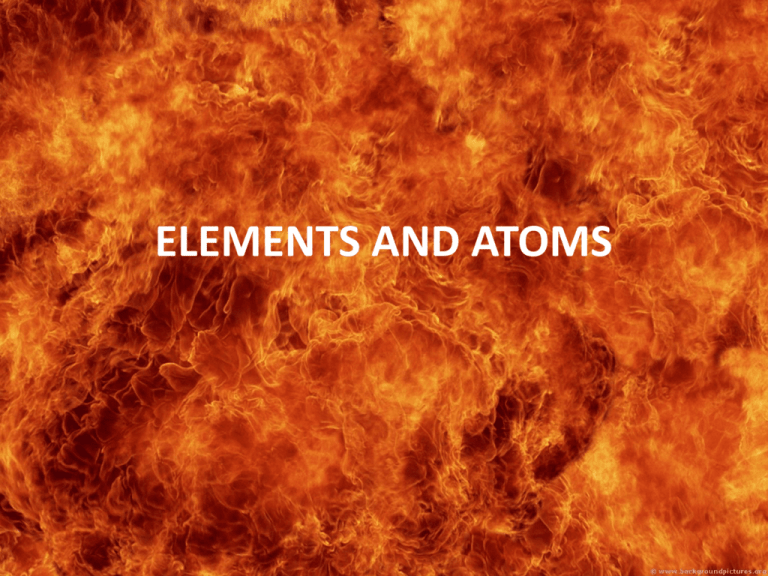
ELEMENTS AND ATOMS • Evolution of the Element Theory – – – – Monists Four Elements and Alchemy Phlogiston and the Study of Airs Lavoisier and Chemistry • Discovery of Elements – Electrolysis – Spectroscopy – Periodic Laws • The Electron • Discovery of the Nucleus • Models of the Atom The Presocratic Monists All material is made of one elementary substance: – Thales of Miletus (624-546 BCE): all is water – Anaximander of Miletus (610-546 BCE): all is apeiron – Anaximenes of Miletus (585-528 BCE): all is air – Heraclitus of Ephesus (535-475 BCE): all is fire (=change) – Pythagoras of Samos and Croton (570-495 BCE): all is number – Democritus of Abdera (460-370 BCE): all is atom FOUR ELEMENT THEORIES • Attributed to Empedocles of Agrigentum (490-430 BCE) and formalized by Aristotle of Stagira (384-322 BCE). • According to Aristotle in his On Generation and Corruption: – Air is primarily wet and secondarily hot. – Fire is primarily hot and secondarily dry. – Earth is primarily dry and secondarily cold. – Water is primarily cold and secondarily wet. FOUR HUMOR THEORY Humor (χυμός, chymos = sap or juice) Formalized by Hippocrates of Kos (460-370 BCE) who tied a mechanistic theory of disease to the 4 elements and the weather. INFLUENCE OF ALCHEMY • Egyptian material religion [Khemeia (χημεία), meaning black (for the hidden arts) or black earth (an ancient reference to Egypt)]. With arabic prefix al-, it becomes al-khemeia or alchemy. • Purpose to improve material • Used careful methods and precise measurements • Introduced to Greek Natural Philosophy • Continued and augmented by alchemists in the Islamic Empire Paracelsus and Iatrochemistry • Took name Paracelsus, which means greater than Celsus, author of a 1st century medical encyclopedia • Rejection of Hippocrates’ theory of health and Galen’s anatomy • Merger of alchemy and medicine • Three principles: sulfur, mercury, salt • The poison is the cure Philippus Aureolus Theophrastus Bombastus von Hohenheim 1493-1541; Switzerland and Austria German Iatrochemical School • Johann Joachim Becher, devised theory of combustion based on phlogiston [from Greek φλογιστόν- phlogistón (burning up)] • Georg Ernst Stahl, provided experimental support for phlogiston Becher, 1635-1682, Present-day Germany and England Stahl, 1659-1734, Present-day Germany Chemistry of Phlogiston 1728-1799 The Study of Airs • Joseph Black: fixed air (carbon dioxide) • Henry Cavendish: inflammable air (hydrogen) • Joseph Priestley: dephlogisticated air (oxygen) 1731-1810 1733-1804 Priestley, son of the Enlightenment • Dissenting clergyman • Theologian and founder of Unitarianism • Educator (English Grammar & Chart of History) • Political theorist • Inventor (soda water; erasers) • Natural Philosopher – electricity – gasses Antoine-Laurent de Lavosier • Minor nobility of France • Degree in law but never practiced • Early work on Geology, chemistry of minerals, and meteorology • Began the study of combustion and noted that sulfur and phosphorus increased in weight after burning • Thus, phlogiston would have to have negative weight • Met Priestley (1774) • Began work on oxygen (1775) and rejected phlogiston theory Marie-Anne (1758-1836) and Antoine (1743-1794) Elements of Chemistry • Published in 1789 • Contained 55 substances that could not be decomposed into simpler substances (elements) • Statement of conservation of mass • First modern text that defined the science of chemistry • Lavoisier had offended Marat and had been a member of a tax collecting commission • Judgment of the court: The Republic needs neither scientists nor chemists; the course of justice cannot be delayed. • Despite important work on the Gunpowder Commission and his support of the revolution, he was beheaded in May 1794 at age 50. Humphry Davy • Lavoisier's theory of elements quickly took over • Davy used Volta’s pile to decompose substances by electrolysis and discovered magnesium, boron, and barium • Chemistry of chlorine and iodine • Mentor to Michael Faraday 1778-1829 Electrolysis of sodium chloride John Dalton • Interpreted the gas laws to mean that elements must exist as atoms • Reactions are interactions of atoms • Atoms combine in whole number ratios (Laws of simple and multiple proportions) • Atoms cannot change (Law of constant composition) • Atoms have a constant weight; so the total mass of reactants must equal the total mass of product (Law of equivalent weights) 1766-1844 • System of Dalton • Worked to define atomic weights based on Hydrogen = 1 Jöns Jacob Berzelius • Defined modern notation • Set weight of Oxygen = 100 and other elements relative to that • Confirmed law of simple and multiple proportions and supported Dalton’s atomic theory 1779-1848, Sweden Problem with Hydrogen Solved • Amadeo Avagadro (17761856, Italy) proposed equal volumes of all gasses at the same temperature and pressure contain the same number of molecules • Only possible if diatomics exist • Berzelius adamant: no diatomics possible • Diatomics supported by Stanislao Cannizzaro (18261910, Italy) H + Cl = HCl Unless hydrogen and chlorine exist as diatomics, this reaction should produce only one volume of HCl. Spectroscopy • Robert Wilhelm Bunsen and Gustav Robert Kirchhoff (Germany) • Spectroscope (1859) • Used spectral signatures to search for new elements Kirchhoff (1824-1887); Bunsen (1811-1899) Discovery of Helium • August 18, 1868; unusual spectral line detected in solar chromosphere during a solar eclipse Periodic Laws • The elements seemed to have repeating or periodic properties according to molecular weights • Thus, elements appeared to occur in families like the halogens: Fluorine, Chlorine, Bromine, Iodine, all of which have similar combining properties Development of Periodic Laws Independently defined and formalized into tabular form by Dimitri Ivanovich Mendeleev (1869) and Julius Lothar Meyer (1870) Meyer, 1830-1895, Germany Mendeleev, 1834-1907, Russian Empire Discovery of the electron Sir Joseph John (J. J.) Thomson (1856-1940) Discovery of the Nucleus Ernest Rutherford, 1st Baron Rutherford of Nelson (1871-1937; New Zealand, Canada, and Britain) The Bohr Atom Niels Henrik David Bohr (1885-1962; Denmark) Electron Shells Glen Seaborg Discoverer of plutonium and 9 other transuranium elements Removed the rare earths to make the table more compact Advisor to presidents from Truman to Clinton Former head of the AEC 1912-1999, USA



